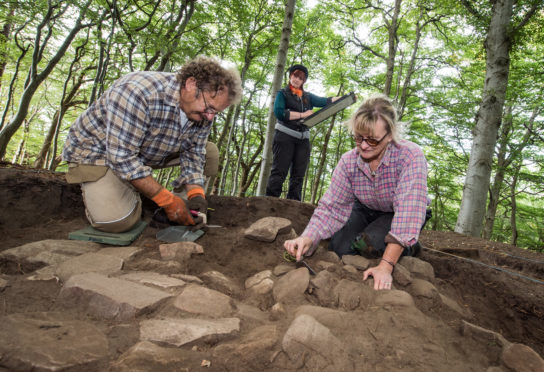Archaeologists have descended on one of Moray’s most famous hills to dig up more evidence of a Bronze Age fort.
Cluny Hill in Forres is the site of excavations for the next two weeks, as a team of experts and volunteers investigate the remains of a fort dating from approximately 800 BC.
This is the second year of the dig after radiocarbon dating of samples found in 2017 proved the existence of the hillfort.
A hillfort is an elevated site usually used as a fortified refuge or a defended settlement, taking advantage of the rise in the land to do this.
Stonework and paving discovered so far on Cluny Hill have provided evidence of an iron smelting location, with the stones potentially forming part of the hearth.
Michael Sharpe, an archaelogist taking part in the dig, hopes they will find out more about the exact use of the hillfort.
He said: “We are looking again at the ditches here to see what kind of hillfort it was, whether its a defended one or just one used for cattle farming.
“We are also revisiting the trench to find more evidence of iron smelting through stonework that was used as a hearth to make iron objects.
“The whole idea is to flesh out what we found last year and hopefully find some more ceramics and pottery and if we are really lucky find some evidence of habitation here.”
Led by Professor Leif Isaksen, a Forres local who now teaches digital humanities at the University of Exeter, the dig aims to find more about the hillfort that appears on old ordnance survey maps from the 1700s.
There has long been a tradition that the hillfort once surrounded the summit of Cluny Hill but major landscaping and plantation undertaken at the site during the 19th century were thought to have destroyed all evidence of the fort.
The dig is on from Monday September 10 until Friday September 21 and is run through the Friends of the Falconer Museum and funded with cash from the Berryburn Windfarm Community Fund.
Not much is known about the hilltop enclosure that used to sit on Cluny Hill in Forres but it is hoped this two-week long dig will solve the mystery.
In 2017, the first year of excavations proved the existence of the hillfort and dated its periods of use to the Late Bronze Age and the Early Iron Age.
Various historical reports and Ordnance Survey maps from the 1700s all but confirm the fact that it did exist.
It has been previously been attributed to different periods of time, including to Neolithic and Middle Iron Age tribes, Pictish warlords, Scottish kings and Viking raiders.
Cluny Hill was heavily landscaped and planted on in the 19th century, and this was thought to have destroyed all evidence of the hillfort.
However, thanks to these digs, the presence of a large hilltop enclosure is now almost certain.
It is now up to the dig team to find out exactly what the hillfort was used for, whether it became a base for herding livestock like or was used as a fortified and protected homestead.
Recent discoveries of stone paving used for iron smelting has only furthered the belief that it was a lived in settlement.
